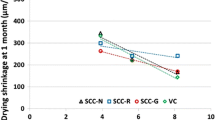Abstract
Natural drying of concrete specimens involves a desiccation shrinkage, which can produce significant cracking. The knowledge of its evolution may allow us to estimate the final configuration of the drying cracks. To achieve this, experiments with a micro-concrete have been performed. The visualisation of the cracking network at different ages of drying, and the recording of different types of shrinkage and of high humidity gradients near the surface could be carried out.
One cubic test piece of 1 m side was manufactured, and a reliable procedure for studying the cracking process is shown. Also displayed is a strict method for analysing the geometrical characteristics of the crack network with the help of image analysis and some basic concepts of the Statistical Physics of Disorder.
The influence of the drying element's dimensions is shown in an experimental model made with clay and sand. Among the results, two curves are particularly interesting: one translates the correlation between the initial dimensions of the drying elements and the final mean crack spacing, and another enables estimating the times of the beginning and end of the cracking development.
Résumé
Le séchage des pièces en béton entraîne un retrait de dessiccation qui peut provoquer une fissuration importante. La connaissance de son évolution permettrait d'estimer la configuration finale des fissures. C'est dans ce sens que des expériences ont été menées sur un micro-béton. La visualisation du réseau de fissuration à des âges différents de séchage, la mise en évidence des différents retraits et des forts gradients d'humidité au voisinage de la surface ont pu être obtenus.
Une seule éprouvette cubique de 1 m d'arête a été réalisée et l'on montre un chemin expérimental fiable pour le suivi du processus de fissuration, ainsi qu'une démarche rigoureuse pour l'analyse des caractéristiques géométriques des réseaux de fissures à l'aide de l'analyse d'images et des concepts de la Physique Statistique du Désordre.
L'influence des dimensions de la pièce a été mise en évidence sur un modèle expérimetal réalisé avec de l'argile et du sable. Parmi les résultats, deux courbes sont particulièrement intéressantes: l'une qui traduit la corrélation entre les dimensions initiales des pièces et l'espacement moyen final entre fissures et l'autre qui permet la détermination des temps de début et de fin de progression de la fissuration.
Similar content being viewed by others
References
Acker, P., ‘Comportement mécanique du béton: apports de l'aproche physico-chimique’, Rapport de Recherche LPC (152) (1988).
Acker, P. and Moranville M., ‘Physicochemical mechanisms of concrete cracking’, in ‘The Materials Science of Concrete’, J. P. Skalny ed. (American Ceramic Society, 1991) ch. 7.
Colina, H., De Arcangelis, L. and Roux, S., ‘Model for surface cracking’,Phys. Rev. B 48(6) (1993) 3666–3676.
Herrmann, H., ‘Introduction to basic notions and facts’, in ‘Statistical Models for the Fracture of Disordered Media’, H. Hermann & S. Roux eds. (Elsevier, 1990) 1–31.
Acker, P., ‘Large-scale heterogeneities and size effects’, in ‘Statistical Models for the Fracture of Disordered Media’, H. Herrman & S. Roux eds. (Elsevier, 1990) 52–58.
Colina, H., ‘Maîtrise de la fissuration de peau du béton: étude géométrique et modélisation’, Ph.D. Thesis, (Ecole Nationale des Ponts et Chaussées, Paris, France, 1992).
Colina, H., ‘Drying cracks Application of the choas theory’, only available in Spanish, in Proceeding of the 1st International Symposium of Structures Geotechnics and Construction Materials, Santa Clar, Cuba, Oct. 1994 (University of Oviedo, Spain, 1995).
Colina, H. and Nelson, E., Final Report of 581 Research Project, only avaiable in Spanish, (Research Council of the National University of Salta, Argentine, 1998).
Meakin, P.,Thin Solid Films 151 (1987) 165.
Skjeltorp, A. T., in ‘Time Dependent Effects in Disorder Materials’, R. Pynn & T. Riste eds. (Plenum, 1987).
Colina, H. and Roux, S., ‘Experimental model of cracking induced by drying shrinkage’,Europ. Phys. Journal E, pre-print, (199).
Granger, L., Torrenti, J.-M. and Acker, P., ‘Thoughts about drying shrinkage: scale effects and modelling’,Mater. Struct. 30 (196) (1997) 96–105.
Deeds, P., Grimaldi, G. and Olivier, G., ‘Détection de fissures sur béton par la méthode de ressuge’, Notice technique LREP, (1989).
Attolou, A., ‘Étude du séchage du béton par gammadensimétrie’ Compte Rendu LCPC (AER 130114) (1985).
Feder, J. ‘Fractals’, (Plenum Press, 1988).
Roux, S. and Hansen, H.,Europhys. Lett. 8 (1989) 729.
Author information
Authors and Affiliations
Additional information
Editorial Note Dr. Paul Acker is a RILEM Senior Member and the RILEM National Delegate for FRANCE. He is a member of RILEM TC 114-CCS: ‘Computer programmes for creep and shrinkage analysis of concrete structures’. He is a corresponding member of RILEM TC 129-MHT: ‘Tests methods for mechanical properties of concrete at high temperature’ and of RILEM TC 107-CSP: ‘Creep and shrinkage prediction models’.
Rights and permissions
About this article
Cite this article
Colina, H., Acker, P. Drying cracks: Kinematics and scale laws. Mat. Struct. 33, 101–107 (2000). https://doi.org/10.1007/BF02484164
Received:
Accepted:
Issue Date:
DOI: https://doi.org/10.1007/BF02484164




